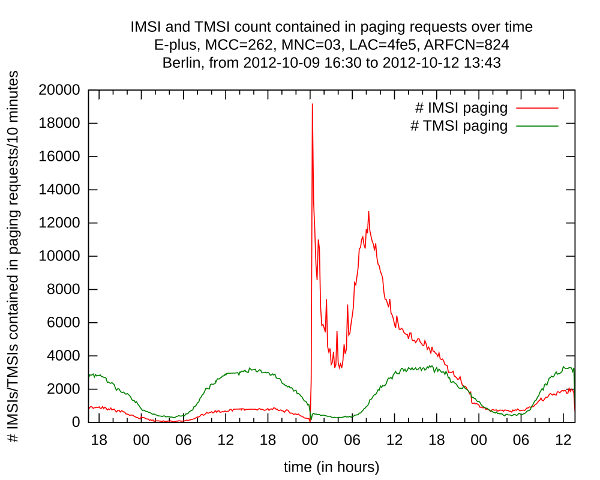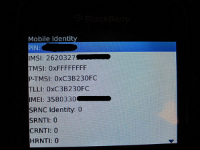I recently noticed a problem in E-Plus' (one of the four major German mobile operators)
GSM network involving their TMSI allocation procedure.
Other providers such as Simyo, BASE, Ay Yildiz, Aldi talk and MTV Mobile are also using the E-Plus network (those are actually either
MVNOs or real subsidiaries).
This began when I bought a blau.de
SIM card for some research and noticed that I did not get any TMSI assigned.
blau.de is part of the E-Plus group which a brand of KPN.
As you can see in this picture, the Blackberry engineering screen displays a TMSI of 0xFFFFFFFF which by the GSM specifications is an invalid TMSI and equals to not having a TMSI at all.
Before I explain what a TMSI is, I have to explain what an IMSI is.
International Mobile Subscriber Identity
In a mobile network, your mobile phone is usually identified by the so-called
IMSI which is a unique identification number associated with your SIM card (also for 3G and 4G).
This identification number can be used by the network to address services to a subscriber, most importantly during the
paging procedure (see
3GGP TS 04.08 for more details). So in the network, the subscriber is not identified using his phone number.
Whenever the network wants to deliver for example a phone call or an SMS message to your phone, it has to notify your phone that there is an incoming service.
And this is done using a mobile identity such as the IMSI.
What's the problem with IMSIs? Why should I care?
The problem with IMSIs is that the mobile identity is sent over-the-air in several protocol messages that can be observed by anyone in clear-text, e.g., as part of a paging request.
Since it is possible to map a mobile phone number to the IMSI (by using
HLR lookup services), being able to observe those IMSIs on the air interface implies that you can tell whether a person is present in a specific area or not if you call the person, if you send an SMS message or even by sending a
silent SMS.
So in practice, this is a privacy problem which allows for easy tracking by just observing protocol messages on the air interface.
Another good reason to not reveal IMSIs is because it can be used as a shared secret key in
OMA DM provisioning SMS.
These SMS are used by operators to configure for example APN settings of your mobile device. So if you know the IMSI, your phone supports OMA DM and no other mitigation is in place, knowing the IMSI of a victim could also allow you to hijack mobile data connections. If you are more interested in this topic, I can highly recommend the great
talk by Cristofaro Mune, Roberto Gassira', and Roberto Piccirillo.
Now what is a TMSI?
To solve this problem, the GSM specs advise to use the so-called
TMSI (Temporary Mobile Subscriber Identity) instead.
This is a 4 byte identifier which is used by the network to map to the IMSI/subscriber and which (hopefully) frequently changes and is not pre-computable by an adversary.
So while it is still possible to see these mobile identites on the air interface, you are not able to map this to a specific phone number anymore.
Actually this is not entirely true, there are also methods to determine the TMSI of a victim, but it significantly raises the amount of work an interested party would need to put into tracking a victim.
In this particular case though, E-Plus was not assigning TMSIs to subscriber anymore and therefore made it extremely easy to track people by using their IMSIs.
While there is no legal constraint that forces operators to use TMSIs, this is considered good practice nowadays for privacy reasons.
The more often these TMSIs are reallocated, the more difficult is it to track subscribers unless you can precompute the next TMSI.
How can this happen?
I don't know what exactly caused the problem in the E-Plus network so I can only guess what the problem is.
In a mobile network, the entity that is responsible for assigning TMSIs is the VLR (Visitor Location Register). Usually each of these handles a specific geographic area and there is usually more than one in a network.
For example from what I know there is one specifically responsible to handle Berlin.
Sometimes it happens that the VLR TMSI pool overflows so that the network starts using IMSIs.
I don't know the technical background on why this happens. I would expect that this is a database problem that can be handled technically

I suspect that in this particular case, after such an overflow the E-Plus VLR in Berlin (where I noticed this), for an unknown reason stopped assigning new TMSIs.
This also means that subscribers who already had a TMSI at that time, will keep it and not get a new one.
Together with my colleague Kevin Redon, we started analysing the paging requests that we can observe on the air interface to see how this may change over time.
Referring to Karsten Nohl of the
gsmmap project,
98% of all E-Plus transactions were using TMSIs before this event occurred.
What we monitored in the last days is that the TMSIs in mobile identities contained in paging requests of E-Plus
only account for 63.9%.
While this is still a seemingly high number, keep in mind that subscribers with a valid TMSI didn't get new ones on reallocations.
How can you test this yourself?
A complete explanation would be out of scope of this post.
However, the Free Software
baseband implementation
Osmocom-BB allows you to play with GSM networks.
You can find information on how to use this software exactly on their website.
So by just having an E-Plus SIM and using their layer1 firmware in combination with the layer23 application running on your computer, you can connect to the E-Plus network and display your subscriber information on the vty interface (show subscriber).
If it doesn't show you the TMSI or it's 0xffffffff after registering successfully with the network, you will know that no TMSI was assigned to you.
Alternatively, Blackberry devices contain a great engineering menu (which you see in the above picture) which can be
enabled with a special code.
Also if you are lucky, you can find some of the old Nokia 3310 devices and the like on ebay for which you can enable the fieldtest mode (netmon).
By now E-Plus has been working on the problem for roughly two weeks and I was told it is fixed for now.
This seems true, I do get TMSIs assigned.
However when looking at the amount of IMSIs and TMSIs contained in paging requests, it seems that it takes quite some time until this is resolved throughout the network.
So it will probably take a couple of days, if not weeks until we hopefully observe patterns that reflect the 98% as measure by gsmmap.
Visualising TMSI/IMSI usage
The best way to visualize the usage of TMSIs and IMSIs is to plot the amount and type of mobile identities contained in paging requests.
For this we logged paging observerd on the air interface on multiple locations over time. Here is an example that shows you how this changed over time:

As you can see there is a high peak of IMSI paging at yesterday around 00:00, paging almost 20000 subscribers. We also observed similiar scenarios in other location areas.
We suspect that this is the point in time when they fixed this issue by restarting equipment.
Specifically the VLR serving the area in which we were taking measurements.
We don't have a definitive reason for this peak, but a plausible explanation could be that they paged each IMSI in the area (so-called Location Area) we were logging in to assign new TMSIs after restarting equipment.
But again, we don't know the reason. It's obvious though that some changes were made in the network at that time.
As you can also see the number of IMSI paging is getting lower, while the TMSI paging is getting higher, indicating that this problem is improving currently.
Thanks to Karsten, Luca, Kevin, Tobias and others for verifying this problem at several locations with several SIM cards!
I would also like to point out that the security contact with the E-Plus team has been great.
After miserable experiences with operators in the past, this has been a good one to me.



